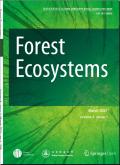森林经营和生境连续性对目标附生苔藓物种遗传结构和生态廊道的影响——绿凤头草景观遗传研究
IF 4.4
1区 农林科学
Q1 FORESTRY
引用次数: 0
摘要
森林生态系统中栖息地破碎化对生物多样性构成重大威胁,破坏生态走廊,限制基因流动,威胁持久性,特别是对依赖森林的物种。在这些物种中,林地特有的苔藓植物是最濒危的物种之一,其中具有高保护价值的附生苔藓绿藓属(Dicranum viride)受到国际法规的保护,体现了这种保护问题。尽管其合法地位,但影响其遗传连通性和传播潜力的因素仍然知之甚少。在这项研究中,我们将基于全基因组单核苷酸多态性(SNP)标记的分子分析与空间模型(包括最小成本路径(LCP)分析和基于电路的连通性模型)相结合,评估了中欧温带森林生态系统中森林连续性和管理对绿桫椤遗传结构和生态走廊的影响。我们的研究结果揭示了一个复杂的扩散动态,结合了短距离克隆繁殖和罕见的长距离扩散事件。遗传聚类分析表明,长期的森林连续性支持独特的遗传谱系。LCP分析和基于线路的连通性模型表明,自然再生的森林(反映管理制度)和具有长期连续性的森林(反映生境年龄和历史稳定性)提供了生境渗透率最高的扩散走廊。我们的研究结果强调了长期生境稳定性在维持绿足鼠遗传多样性和种群动态中的关键作用。养护战略应优先考虑保护成熟森林、维持生态走廊和整合保留森林的做法,以支持附生苔藓植物。我们的研究提高了对景观连通性如何影响珍稀附生苔藓植物持久性的理解,为保护生物多样性和可持续森林管理提供了实践见解。本文章由计算机程序翻译,如有差异,请以英文原文为准。
Effects of forest management and habitat continuity on the genetic structure and ecological corridors of target epiphytic moss species: A landscape genetic study of Dicranum viride
Habitat fragmentation in forest ecosystems poses a major threat to biodiversity, disrupting ecological corridors, limiting gene flow, and threatening persistence, especially for forest-dependent species. Among these species, woodland specialist bryophytes represent one of the most endangered groups, with Dicranum viride, an epiphytic moss of high conservation value protected under international regulations, exemplifying this conservation concern. Despite its legal status, the factors that influence its genetic connectivity and dispersal potential remain poorly understood. In this study, we integrated molecular analyses based on genome-wide single-nucleotide polymorphism (SNP) markers with spatial modelling, including least-cost path (LCP) analyses and circuit-based connectivity models, to assess the impact of forest continuity and management on the genetic structure and ecological corridors of D. viride across temperate forest ecosystems of Central Europe. Our results revealed a complex dispersal dynamic that combines short-distance clonal propagation with rare long-distance dispersal events. Genetic clustering analyses indicated that long-term forest continuity supports unique genetic lineages. LCP analyses and circuit-based connectivity models demonstrated that naturally regenerating forests (reflecting management regime) and forests with long-term continuity (reflecting habitat age and historical stability) provide dispersal corridors with the highest habitat permeability. Our findings highlight the critical role of long-term habitat stability in maintaining the genetic diversity and population dynamics of D. viride. Conservation strategies should prioritise the protection of mature forests, the maintenance of ecological corridors, and the integration of retention forestry practices to support epiphytic bryophytes. Our study improves the understanding of how landscape connectivity influences the persistence of rare epiphytic bryophytes, offering practical insights for the conservation of biodiversity and sustainable forest management.
求助全文
通过发布文献求助,成功后即可免费获取论文全文。
去求助
来源期刊

Forest Ecosystems
Environmental Science-Nature and Landscape Conservation
CiteScore
7.10
自引率
4.90%
发文量
1115
审稿时长
22 days
期刊介绍:
Forest Ecosystems is an open access, peer-reviewed journal publishing scientific communications from any discipline that can provide interesting contributions about the structure and dynamics of "natural" and "domesticated" forest ecosystems, and their services to people. The journal welcomes innovative science as well as application oriented work that will enhance understanding of woody plant communities. Very specific studies are welcome if they are part of a thematic series that provides some holistic perspective that is of general interest.
 求助内容:
求助内容: 应助结果提醒方式:
应助结果提醒方式:


